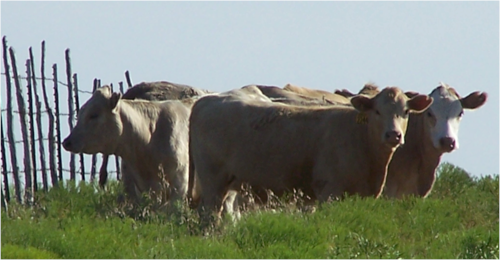Multiple-species grazing has been proven over the years to increase carrying capacity and benefit the range environment, if done correctly. Each type of ruminant we manage, cattle, sheep, goats, and deer all use a unique combination of the different forages in their diet. To get the best use of your pastures, you really need a combination of livestock. Doing it correctly involves utilizing the right mix of animals for the forage you have at a stocking rate that is in balance with the amount of forage you have available.
The concept of increasing carrying capacity from multi-species grazing stems from the fact that each species of livestock has distinct forage preferences. For instance, cattle prefer grasses, and a much smaller amount of forbs and browse. If cattle are the only form of livestock you have, and you have an abundance of forbs and browse, much of your grazable habitat will go underutilized.
Choosing what species to add to your livestock numbers should be based on what types of forages you have. More specifically, what forage you have that are underutilized. The table below illustrates the preferences of each species:
Forage Preferences of Ruminants
| Cattle | Sheep | Goats | Deer |
| Grass | Forbs | Browse | Forbs |
| Forbs | Grass | Forbs | Browse |
| Browse | Browse | Grass | Grass |
By tailoring your mix of animals to the types of forage you have, you can harvest more total pounds of forage in your pastures with more animals. Now don’t misunderstand this. If you have a 90% grass pasture and you add a large group of goats, they will have to eat primarily grass. In this case, if you don’t have an abundance of grass, you will overgraze your grasses. Overgrazing is not the purpose of multi-species grazing.
On the other hand, if you have a large amount of edible browse, adding goats to the pasture would allow use of this browse that the cattle would use very little. In this case, you could increase the pounds of meat produced on your pastures without overgrazing the pastures.
A key word in your planning is “edible”. Just because you have a lot of browse, it may not be edible by the goats. Let’s say you have an abundance of juniper (cedar to west Texans), and you would like to use goats to reduce it. Well it won’t happen. There are chemicals in junipers that restrict the amount that animals can eat. Goats and deer will eat more than other livestock, but they are still limited in how much they can eat. Therefore much of their diet has to come from other sources.
On the other hand, if you plant to use goats to help control seedlings and new growth juniper, and you have an abundance of other browse species that goats do like to eat, then you could add goats to your animals population. How many will depend on how much browse you have.
My suggestion is to start small with your multi-species grazing and build numbers as you learn to manage them. When you see the browse, or other type of forage you are trying to target, begin to show signs of heavier grazing, you are approaching your carrying capacity of that type of livestock.
The same principle would hold for sheep if you were trying to harvest forbs in your pasture. If you are trying to manage annual forbs that depend on rainfall to grow, you may want to use a stocker type of program with them, because you may not have the forbs for them to eat every year. In years you don’t have a forb crop, the sheep will compete for grass with cattle. Or vice versa. So just running stocker lambs when you have an abundance of annual forbs, and not having them in drier years, may be a better choice than a breeding program you will want to keep regardless of forage conditions.
When choosing to add another species of livestock to your grazing program, be sure you are not going to increase the competition for forage with existing livestock enterprises. Let’s say you add sheep and goats to a cattle and deer hunting enterprise. The sheep and goats may compete with the deer, if the forbs and browse becomes limited. Basically, don’t consider adding another type of livestock unless you are sure there is ample forage for your existing operation.
If you have a balanced mix of livestock based on the amounts of the different types of forage available, you will be helping to maintain your pasture resource in a more productive state. There’s an old saying that if you graze a pasture with one species long enough, you will change the forage resources away from what that species needs. Because livestock eat the more preferred and nutritious forages first each year, eventually they will begin to overgraze some of the better plants and lesser plants, for that species, will begin to invade, or become more dominant.
By grazing with a multiple species livestock system, your animals will graze more total species in the pasture and not give some of the invader plants a chance to become dominant. Thus you should be able to keep your livestock habitat in a higher state of productivity.
Multiple species grazing may not be applicable for everyone. There may be fencing or predator problems that prevent you from using it in your pastures. However, if it is feasible for your operation, I think you’ll find it can improve your profitability, as well as help to maintain the quality of your pastures.
Interested in our products? Click here.


